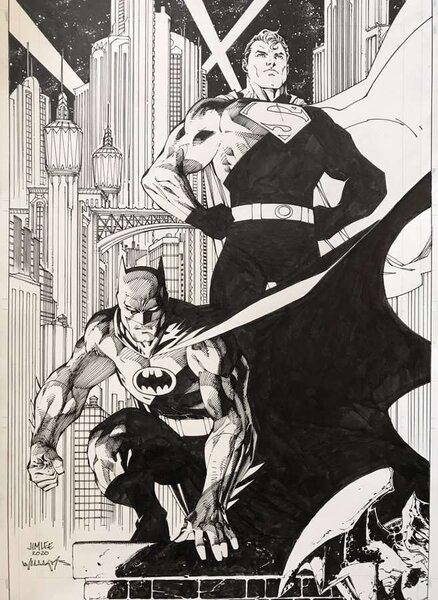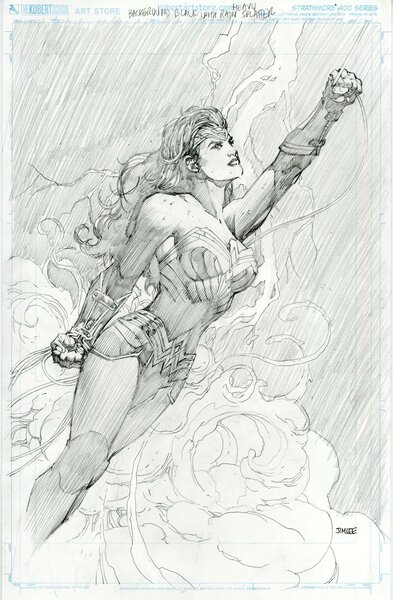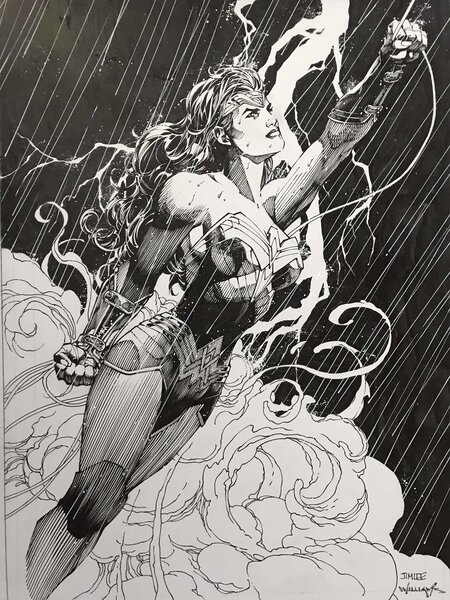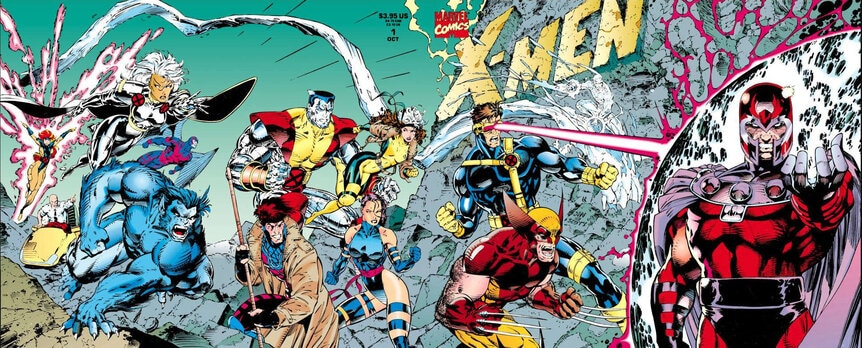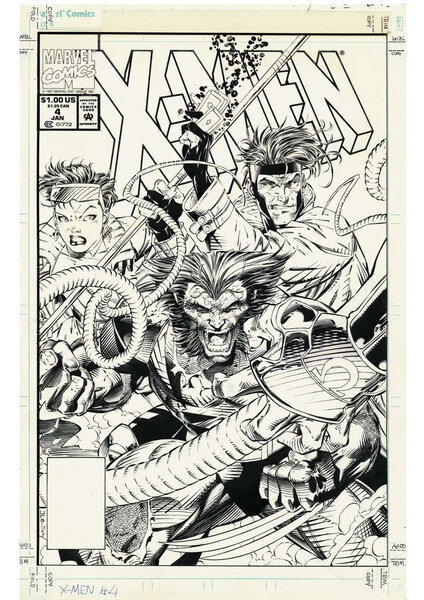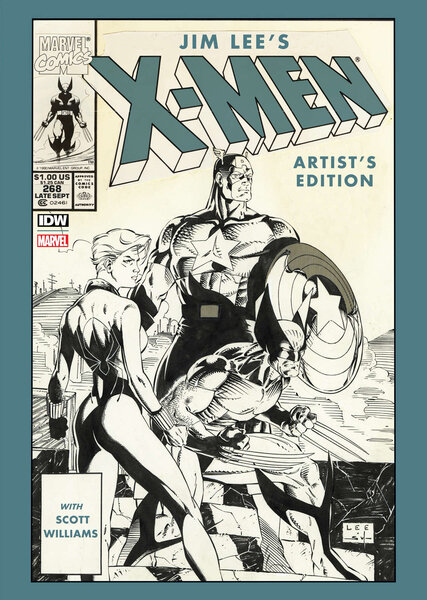Create a free profile to get unlimited access to exclusive videos, sweepstakes, and more!
Master Inker Scott Williams on inking Jim Lee & X-Men deadline woes
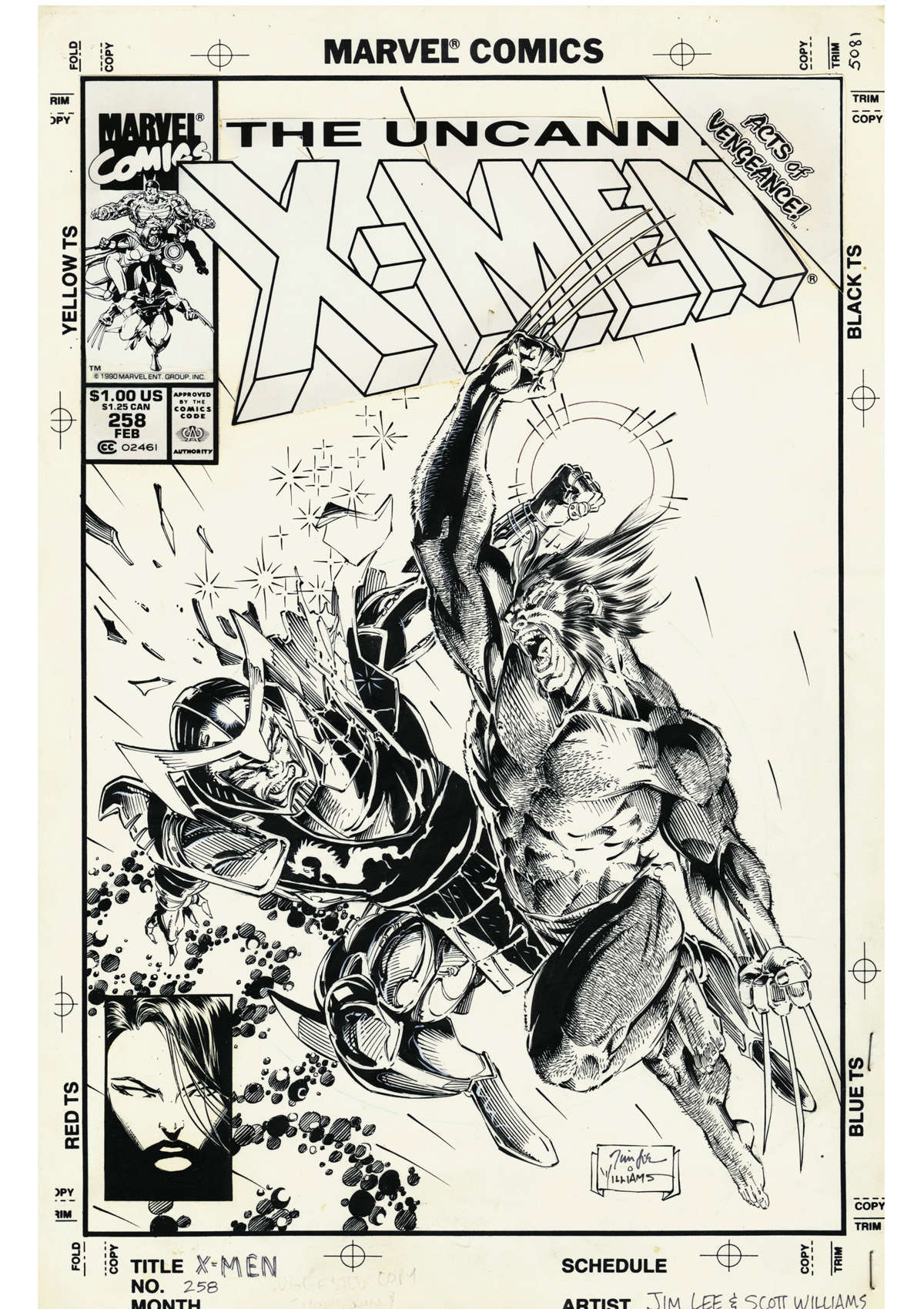
Scott Williams has been one of the top inkers in comics for more than 30 years.
It's rather remarkable for any creator to remain at or near the top for that long in a business that seems to be reinvented and rebooted almost as often as its fictional universes are. Williams has inked some of the biggest names in comics, including Marc Silvestri and Whilce Portacio. But ask any comics fan who grew up on '90s titles and they'll tell you they know Williams, first and foremost, as Jim Lee's right-hand ink man.
Williams was there when Lee shot to fame penciling Uncanny X-Men. When the spinoff series X-Men launched in 1991 with history's top-selling comic, Williams was right there, providing proper weight and clarity to Lee's exquisite pencil work. The two have had one of the longest and most successful bromances in comics history, with multiple blockbuster works under their belt (Batman: Hush, The New 52 Justice League series, Superman: For Tomorrow, the WildC.A.T.S./X-Men crossover), as well as entirely too many covers for us to mention here.
"It's been what, 30 years now? It's fairly unusual for a penciler and an inker to be kind of linked in the way that we have, for as long as we have," Williams tells SYFY WIRE during a career-spanning interview.
Inking is one of the most under-appreciated and misunderstood jobs in comics. Kevin Smith even included a joke at the expense of inkers in 1997's Chasing Amy. Jason Lee's character, Banky Edwards, is an inker who tries to throttle a fan who insults him and calls him "a tracer." Williams is all too familiar with that memorable scene. While he can certainly have a good-natured laugh at his own expense, the artist thinks inkers get taken for granted — and get very little credit for a project's success — because most fans don't really know exactly what an inker does.
"I do think it comes down to just a lack of understanding as to whether or not the inker has the skills to pull a drawing out of the fire," Williams says. "There are a lot of times where deadline strikes and the penciler is not able to give all the information within a given page that is required. Therefore it's the inker who has to bring it over the finish line by finishing the page, by taking something that is vague and clarifying it by creating depth by adding to the drawing. That's ultimately what an inker does."
As William notes, when a deadline looms, inkers often turn into "finishers" who tighten up drawings, add backgrounds, and even fix mistakes on the page. The truly elite talent often get asked by editors to salvage a subpar penciling job.
Good inkers are hard to find; great ones, next to impossible. So when pencilers find the perfect partner, they tend to stick together for awhile. It's why John Romita Jr. and Scott Hanna have worked together for so many years. It also probably helps explain why the Lee-Williams relationship is still going strong, all these years later.
Williams steps away from his art board for a few minutes to talk with SYFY WIRE about his career in comics. Below, he opens up about the inkers who influenced him, and we touch on career highlights that include the aforementioned X-Men #1. In fact, he shares a longstanding gripe about the artwork published in that legendary comic. We also talk about an upcoming release from IDW, the Jim Lee X-Men Artist's Edition featuring scans of the original art from that glorious late '80s-early '90s X-era. Read on and enjoy!
How did you end up on a career path as an inker, instead of a penciler?
Scott Williams: I've been approached a bunch of times by people wanting to get into business as an inker because they think it's kind of a bit of a cheat, a shortcut. They could get all the glory and all the chicks by being an inker, without having to do the work. But at the end of the day, all the best inkers, in particular the ones you could name, they all are pretty solid artists. And that is one of the biggest qualifications of being an inker. He or she has to know how to draw.
But there's usually some hitch in their step or some aspect that they can't bring to the table that keeps them from penciling comics full time. I know for me, it was always a matter of speed. I mean, there are a lot of things I could get better with drawing, don't get me wrong. There's a lot of things I could improve on, but ultimately it was always about speed. I was much more efficient, therefore much better able to pay the bills, by being an inker than I was as a penciler.
How useful was your speed back in the early days when you were at Marvel with Jim Lee on the X-Men?
It's a requirement. I think it's true of both pencilers and inkers. And especially as I was getting my career going, you really kind of needed to be able to manage a page a day, whether you're penciling a page a day or inking a page a day. If you're an inker and you're inking a page a day, odds are, you're probably being able to keep up with whoever [is your penciler]. If you can [do that] you can produce a monthly book, that's 20 to 24 pages a month plus a cover, give or take.
Now if you're Jack Kirby or John Buscema, who could bang out like six pages a day, so much the better. But that was insane. I mean, it was a whole different world [in those days] and I hesitate to say what they were doing was simpler because that wasn't always the case. It was just a different style. A lot of the stuff that the comics are doing right now is a lot more illustrative, just a lot more kind of detail oriented. It doesn't mean it's better. There's a lot of guys today that put in a lot of detail and it's not necessarily that great.
Do you have a good story from the X-Men days of having to pull an all-nighter to save a book from missing deadline or a cover that you and Jim had to turnaround quick to beat a deadline?
Sure. I mean, we had a couple of them. Probably the most memorable one, which was during our [Uncanny X-Men] run. It was our little studio, which was Homage Studios: me, Jim, and Whilce Portacio. And we had to turn around one issue of X-Men that came kind out of left field. The X-Men office was in a jam. They basically said, "We're desperate. Could you possibly get an issue done in about a week?" You're talking pencils and inks. Jim's like, "Yeah, we can do that." Great. Thanks Jim!
So we all kind of ganged up together, so it wasn't exactly just a two-person job. This was definitely a three-person job. It was a studio banded together and playing to our strengths. Each of us kind of doing the part that we were best at. And we cranked out the book in just over a week.
I think those of us who aren't in the comics-making business sometimes don't realize how relentless the grind is on monthly comics. For example, back then, you guys went right from Uncanny X-Men directly into launching X-Men, didn't you?
We pretty much finished our run on Uncanny X-Men leading up to that first issue in normal time. So basically we were struggling and grinding and getting the issues done. And then, our next issue is one of our biggest opportunities: X-Men #1. Oh, and it's double-sized and you have multiple pinups in it. The whole nine yards and obviously a lot of eyes and a lot of pressure on us to do a good job with it. That first issue was basically done in roughly the same amount of time that we do a normal issue. So that was not specifically one all-nighter, but multiple all-nighters. And I do remember [X-Men #1] being the one issue where I was probably on fumes the most, and it wasn't because of the story. I think we finished the main story fine. The last thing that we saved were the four pinups that were inside.
There was four pinups on the inside cover or back cover. One of the pinups I did was the villains one. I remember that being probably the last one that we did and I was just gasping for air. It was fun. It was exhilarating, but there does come a point where your ability to just keep going, it's taxed. And I was feeling pretty taxed. So there was a lot of good things about it, a lot of great aspects to doing that book, but I was running on empty at that point.
Your partnership with Jim is how I think most fans identify you. Your partnership has created so many killer comics memories. But if we're being honest, Scott, you probably could have picked an easier penciler to ink all the time. Jim's detailed art can't be easy to ink!
No one held a gun to my head. I could have walked away at any time! (Laughs) I think it went both ways and I think Jim would probably say the same thing. I had a pretty established inking style when Jim got into the business, and he liked it and he kind of ran with it. He kind of penciled to my strengths. There was a lot of things that he would put in the pencils, which weren't really native to his style, but sort of fit the type of line and the type of look that I was looking for. So when you go back and look at some of the early pencils that he did, you'll find a lot of my line work in his pencils because he would anticipate that that's what I was going to do anyway. So he put it in there.
I think as time has gone by, his style has sort of cemented itself within, and the type of work that I think he wants to see has kind of been fairly cemented. So I've actually adapted. I've adopted some of the things that he does. I've tried. When he inks himself and we've all seen it [on his social media], it's really energetic. It's way more organic. He's not quite as fussy as I am. Um, he's not quite as OCD on line work as I am. When I think of stuff, I tend to rein it in, it's just sort of who I am as an inker, but as far as borrowing things, I have learned to… it's not about letting things go, it's about allowing happy accidents to happen more, and to be mindful of the fact that just because something is very precise does not make it better.
If you can put some information down quickly, spontaneously and kind of have it, have a little bit of that extra bounce that comes with that moment of creation, go with it. And so that's some of the things that I've kind of pulled from Jim. That ability to not be quite so anal about it. It's still in there. It's still part of who I am as an artist. I'll never be quite as spontaneous as he is, but that's definitely something that I've kind of mindfully tried to pay attention to what he's doing and adopt aspects of it.
What's your favorite Jim Lee-drawn character to ink not named Batman?
That's like picking favorite children and stuff like that. I don't think there's any doubt that the X-Men that we talked about earlier was a huge part of our career and a springboard to other things. And you know, Mike, that I'm pretty much a fan just like everybody else. Wolverine was always a favorite of mine. He's just got a lot of the same dynamics that Batman has. He's a hero, but he is flawed. So there's aspects of his character beyond just the visuals that are appealing. But he is just a fun character to draw. And he's always put into situations that are fun. It's not a surprise that he is sort of a fan favorite. And the way Jim draws him, well, he pretty much nails it.
There's an upcoming Heritage auction that includes the original cover art to one of the most famous X-Men covers you guys worked on, Uncanny X-Men #268. It features one of the coolest Wolverine images, flanked by Cap and Black Widow. Some fans reading this may not be aware that you aren't just paying lip service when you say you're a fan. You're a longtime fan and a big original art collector. And on one of the message boards where collectors like us go to geek out over comic art, someone started critiquing the cover and the logic behind the placement of the three heroes. Why would they just be standing on a rooftop? You gave what I thought was a perfect answer.
Never underestimate the power of looking cool. I mean, it's typical of comics where we're dissecting and trying to figure out why do they look like that when that's not practical? But at the end of the day, when you really think about it, so much of what Jim does just looks great. However you define great. The guys are handsome, they're rugged, they're chiseled. The women are all beautiful, but at the end of the day, he puts 'em in a position he likes in such a way; he uses body language to an advantage, to the point where it just looks cool. And sometimes you don't need to know why those guys are up on the rooftop, striking a pose. It just looks cool.
I'm on record online saying that cover is going to sell for at least $250,000 at the auction, and I may be lowballing it.
I think that's a very safe bet. And it brings home the fact that when I sold it for $650 back in 1990 or 1991, that it might've been a mistake.
Setting aside the pain of that ultimate hammer price for the art, what does it say to you that a cover that you worked on just about 30 years ago is such a cultural touchstone for a huge section of fans? The fact that the art is the centerpiece of a big auction speaks to the impact of your work.
It's gratifying that something we did that long ago is still thought of highly enough. A lot of comics and collecting art, there's a lot of nostalgia involved. When I go to shows these days — when we had shows to go to — by far the most requests I get for autographs are usually from stuff from 25 to 30 years ago. That wasn't the case like five or 10 years ago. But I think, um, as the fan base has grown a little bit older, they look back at those eras of X-Men and the work that we did back then through kind of rose-tinted nostalgia glasses. I mean, we all grew up reading comics, man, and whatever you were reading when you were 12 years old, that was the best.
I wanted to ask you about the upcoming release of IDW's Jim Lee X-Men Artist's Edition (you can find out more info here). These are oversized books that reprint original comic art so you can see it in its purest form. Collectors love these books because they give them a chance to view art pages that are obscenely expensive. For an artist, I imagine it provides a certain validity to the legacy, and a certain time in your career.
Definitely. Those books are a double-edged sword in that as an artist, you always see your own flaws first and foremost. And even if I point it out to people, they, they shrug it off. They don't see it. But I see all the flaws. And there's this: I think if you're an artist, if you ever get to the point where you're really satisfied with everything that you're doing, you've probably hit a dead end. Cause there's always ways, there's always things you can do to improve. But yeah, the Artist's Edition is obviously a bit of an affirmation. The fans are the customers, and they're buying it on the basis of just the imagery alone.
There's something about the art itself that has to be compelling enough. Whether it stands on its own merits or through the power of nostalgia, there's gotta be something about it that compels someone to spend a $100 to $200 on one of these books. So yeah, we're excited. I'm excited, frankly, because it reproduces the entire issue of X-Men #1. And the reason I'm excited about it is first it's work that I'm very proud of. What Jim brought to the table and what I brought to the table was probably about as good as we were capable of doing at that time. The other thing that's cool about it, and I'm going to be interested to see who notices this, who bought those books off the stands and has that as their only point of reference, is that right about that time, Marvel was having problems with reproduction techniques. Which is odd because books that were done in the Silver Age and all the way up to that point in time, generally the reproduction was pretty good, especially considering the fact that it was printed on newsprint with a very limited color palette and whatnot.
But something was happening technically, which we never did figure out. But when those books came out, we were sort of heartbroken because the line work breaks up, it is scratchy and sketchy. The interior pages and the double-page spreads in particular. They printed like crap. They truly did. And it's not just like a certain part of the print run. It's the whole print. It's all the reproductions, it's all the trade paperbacks, the hardbacks. When you look at the original pages, as you'll be able to with the IDW Artist's Edition book, you're going to see a very different level of craftsmanship that was not evident in those books.
Let's wrap things up by talking about your artistic heroes. Which inkers do you hold in the highest esteem?
I was a big Frank Miller and Klaus Janson fan on Daredevil and their whole run. As I was starting to get professional work and still figuring things out, I literally had Klaus Jansen comics laid out next to my drawing table so I could try to see what I could steal. And that's actually what most artists do. They steal stuff and it's a time-honored tradition. There's absolutely nothing wrong with it. If you're a penciler or an anchor out there, and you're trying to figure out what you want to do, you don't have to reinvent the wheel every single time. You can try to figure out what your favorite artists are doing and try to make parts of it your own. What will happen is you will eventually take whatever it is that you're dissecting and you will make it your own and your own style will sort of morph and evolve into something hopefully new. And that's basically what I did. My style came from a failure to adapt to Klaus Janson's style.
Klaus has a very heavy hand as an inker. If you go back and look at some of my early stuff, you'd see it in my work. I was heavier the way that I rendered things, but eventually sort of my own sensibilities kind of grew out from that. My line became specific and I would pick up things from all the artists that I admired, whether it was Neil Adams when he inked himself, or Tom Palmer, another great inker with a very noticeable style.
Who would you say is an underrated inker? The Bronze Age of comics had a lot of candidates for this answer.
Underrated. Wow. That's a tough one. I don't know if anybody significantly younger than me knows or remembers what Bob Wiacek brought to the X-Men. But when he was inking Paul Smith (for a brief stretch in the mid-'80s), it was just gorgeous. It was like a perfect marriage of style. And yet I think some of those same readers who might know my work might not know who Bob is. He also did some really good work on Walt Simonson's pencils on the X-Factor book.
A lot of those older guys were against the gun as far as deadlines go. I discovered early on as a professional that the worst thing you can do is to take on really late books and have to be sort of the savior. Because while that's happening, you're the editor's best friend. Once it's done, they don't appreciate it. And frankly, usually the job you're doing is pretty sloppy. You don't earn a lot of kudos from the fans. Then you start getting a reputation for just putting out product as opposed to something that's got some soul to it.
Hit me up on Twitter/Facebook/Instagram and share your favorite Jim Lee/Scott Williams art. And if you want to see Scott's inking process, give him a follow on Instagram, @ScottWilliamsInks. He regularly shares updates on his work there.
Don't forget that Behind the Panel is a multi-platform series that can help keep you entertained during these strange and stressful times we're in. Our video series is loaded with my in-depth interviews with amazing comic book creators. The Behind the Panel podcast is an audio documentary series that provides unique insight into your favorite creators and stories. Check 'em out, we think you'll enjoy them.
The views and opinions expressed in this article are the author's and do not necessarily reflect those of SYFY WIRE, SYFY, or NBCUniversal.
